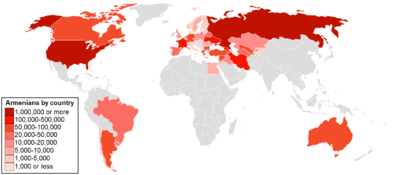Armenians in Singapore
| Total population | |
|---|---|
| (100[1]) | |
| Regions with significant populations | |
|
| |
| Languages | |
| Armenian, English | |
| Religion | |
| Christianity |
| Part of a series on |
| Armenians |
|---|
| Armenian culture |
|
Architecture · Art Cuisine · Dance · Dress Literature · Music · History |
| By country or region |
|
Armenia · Nagorno-Karabakh Republic Armenian diaspora |
| Subgroups |
| Hamshenis · Cherkesogai · Armeno-Tats · Lom people · Hayhurum |
| Religion |
|
Armenian Apostolic · Armenian Catholic Evangelical · Brotherhood · |
| Languages and dialects |
| Armenian: Eastern · Western |
| Persecution |
|
Genocide · Hamidian massacres Adana massacre · Anti-Armenianism |
|
Armenia Portal |
The Armenians in Singapore are a small community who had a significant presence in the early history of Singapore. They numbered around 100 families at their peak in the 1880s, but many have moved on to other countries or become absorbed into the wider Singapore community. They were among the earliest merchants to arrive in Singapore when it was established as a trading port by Sir Stamford Raffles in 1819. The Armenian Apostolic Church of St Gregory the Illuminator on Armenian Street, the first church ever built in Singapore, remains today.
History
The early Armenians of Singapore had their origin in Julfa, whose population were deported to Isfahan (forming New Julfa) by Shah Abbas of Persia after he captured the city in 1603.[2] Some of these Armenians then migrated to India and further beyond, and by the 18th century, Armenian communities had established themselves in India (particularly Kolkata), Myanmar, the Malay Peninsula (particularly Penang and Malacca), and Java. Soon after Sir Stamford Raffles founded Singapore as a trading port in 1819, Armenian merchants arrived in Singapore.[3]
Although small in number, the Armenians were active in the commercial activity of early Singapore. Armenian trading firms such as the Aristarkies Sarkies Company (1820-1841), Apcar & Stephens Company (1826-1845) and Mackertich M. Moses Company (1821-1845) were prominent in Singapore's economy. By the 1830s, Armenian merchants began investing in land. Built in 1835, in March 1836 the Church of St Gregory the Illuminator was consecrated, making it the first church in Singapore.
There were around a hundred families of Armenian in the 1880s. The 1931 census showed 81 Armenians.[3] Many of the Armenians, as British loyalists, were interned during World War II. By the 1950s, much of the local Armenian community had emigrated to Australia or become part of the larger communities in Singapore. Nevertheless, during the Feast of the Epiphany, the flags of Singapore and the Republic of Armenia are still raised at the Armenian church.
Notable Armenians
Catchick Moses (Movessian) (1812-1895), was a co-founder of the Straits Times, which was to become the national English newspaper, in 1845. He sold the paper a year later because it was unprofitable. Catchik Moses died in 1895.
The Sarkies brothers (Martin, Arshak, Aviet and Tigran) founded the Raffles Hotel and several other hotels in Southeast Asia, including Eastern Oriental Hotel in Penang Malaysia and Strand Hotel in Yangon, Myanmar (previously known as Rangon Burma)
Agnes Joaquim was born in Singapore, on 7 April 1854. As the eldest daughter in her family, Agnes helped her mother raise her 10 siblings after her father died.
She never married, dividing her time between the Armenian Church of St Gregory on Hill Street, and her horticulture work in her garden in Tanjong Pagar. In 1899 at a flower show, Agnes unveiled the Vanda Miss Joaquim for the first time, and won the $12 first prize for her flower. As she was suffering from cancer at that time, Agnes died 3 months later at the same year, at the age of 44. In 1981, the Vanda Miss Joaquim was designated Singapore's national flower.
Her tombstone stands in the Armenian Church in Singapore and reads: "In loving memory of Agnes, eldest Daughter of the late Parsick Joaquim, Born 7th April 1854 - Died 2nd July 1899,'Let her own works praise her. Nothing in my hand I bring, Simply to Thy Cross I cling'"
Armenian expatriates in Singapore include Ashot Nadanian, who has coached the Singapore National Chess Team since 2005[4] and Gevorg Sargsyan, conductor of Singapore Camerata Chamber Orchestra and Tanglewood Music School since 2008.[5]
Armenians today
The Armenian community in Singapore remains small. There are around a dozen families in Singapore who are descended from the early immigrant families: Aviet, Carapiet, Galestin, Galistan, Johannes, Moses, Sarkies, and Zechariah.[6] In the 2000s, some Armenians have emigrated from Armenia to Singapore.[1]
See also
References
- 1 2 "175 and Counting: Armenians in Singapore celebrate church anniversary". ArmeniaNow.com. 11 March 2011. Retrieved 5 January 2013.
- ↑ Wright, Nadia (January 6, 2015). "The Armenians of Singapore: An Historical Perspective". The Armenian Weekly.
- 1 2 "Armenian". Singapore Infopedia. National Library Board, Singapore.
- ↑ Intchess Asia Pte Ltd
- ↑ Gevorg Sargsyan - Biography
- ↑ Victor R Savage, Brenda Yeoh (15 June 2013). Singapore Street Names: A Study of Toponymics. Marshall Cavendish Editions. p. 23. ISBN 9789814484749.
Wright, Nadia H. (2003) Respected citizens: The History Of Armenians In Singapore And Malaysia. Melbourne: Amassia Publishing.
